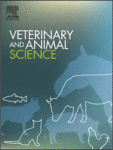Ver ítem
- xmlui.general.dspace_homeCentros Regionales y EEAsCentro Regional CórdobaEEA Marcos JuárezArtículos científicosxmlui.ArtifactBrowser.ItemViewer.trail
- Inicio
- Centros Regionales y EEAs
- Centro Regional Córdoba
- EEA Marcos Juárez
- Artículos científicos
- Ver ítem
Wild pigs (Sus scrofa) population as reservoirs for deleterious mutations in the RYR1 gene associated with Porcine Stress Syndrome
Resumen
Porcine Stress Syndrome (PSS) is a disorder codified by the ryanodine receptor 1 gene (RYR1) and affects both animal welfare and the quality of the meat product. As a consequence, individuals with this syndrome generate great worldwide economic losses in the porcine industry. In Argentina, the Buenos Aires Province is the most involved on this activity, and productions are to be in open field with a higher frequency of pigs with diverse pathologies. On
[ver mas...]
Porcine Stress Syndrome (PSS) is a disorder codified by the ryanodine receptor 1 gene (RYR1) and affects both animal welfare and the quality of the meat product. As a consequence, individuals with this syndrome generate great worldwide economic losses in the porcine industry. In Argentina, the Buenos Aires Province is the most involved on this activity, and productions are to be in open field with a higher frequency of pigs with diverse pathologies. On the other hand, the biggest and oldest wild pigs population is located on the Atlantic coast of Buenos Aires Province, which presents a continuous bidirectional flow of individuals with the productive areas nearby. The aim of this study is to detect the presence of the RYR1 deleterious allele in the wild population from the Atlantic coast of Buenos Aires, in order to evaluate its possible role as a genetic reservoir for said allele. For this purpose, 106 wild pigs from 28 sites were studied, finding a 6.6% of carrier individuals, indicating that the wild population is not free of this allele. This constitutes the first analysis to detect the presence of the RYR1 deleterious allele, associated to the PSS in wild pigs from Argentina, being one of the few studies to report it worldwide and suggesting wild pigs populations to be a possible genetic reservoir for this disease.
[Cerrar]

Autor
Acosta, Diana Belén;
Español, Laureano Ángel;
Figueroa, Carlos Ezequiel;
Marini, Sebastián José;
Mac Allister, Matías Exequiel;
Carpinetti, Bruno Nicolás;
Fernández, Gabriela Paula;
Merino, Mariano Lisandro;
Fuente
Veterinary and Animal Science : 100160 (Available online 14 December 2020)
Fecha
2020-12
Editorial
Elsevier
ISSN
2451-943X
Formato
pdf
Tipo de documento
artículo
Palabras Claves
Derechos de acceso
Abierto
 Excepto donde se diga explicitamente, este item se publica bajo la siguiente descripción: Creative Commons Attribution-NonCommercial-ShareAlike 2.5 Unported (CC BY-NC-SA 2.5)
Excepto donde se diga explicitamente, este item se publica bajo la siguiente descripción: Creative Commons Attribution-NonCommercial-ShareAlike 2.5 Unported (CC BY-NC-SA 2.5)


